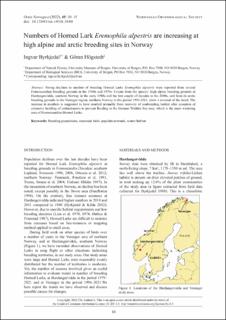| dc.contributor.author | Byrkjedal, Ingvar | |
| dc.contributor.author | Högstedt, Göran | |
| dc.date.accessioned | 2022-12-22T12:48:42Z | |
| dc.date.available | 2022-12-22T12:48:42Z | |
| dc.date.created | 2022-10-12T10:48:12Z | |
| dc.date.issued | 2022 | |
| dc.identifier.issn | 1892-9737 | |
| dc.identifier.uri | https://hdl.handle.net/11250/3039248 | |
| dc.description.abstract | Strong declines in number of breeding Horned Larks Eremophila alpestris were reported from several Fennoscandian breeding grounds in the 1960s and 1970s. Counts from the species’ high alpine breeding grounds at Hardangervidda, southern Norway in the early 1980s and the first couple of decades in the 2000s, and from its arctic breeding grounds in the Varanger region, northern Norway in the period 1996-2021, show a reversal of the trend. The increase in numbers is suggested to have resulted primarily from recovery of nonbreeding habitat after cessation of extensive building of embankments to prevent flooding in the German Wadden Sea area, which is the main wintering area of Fennoscandian Horned Larks. | en_US |
| dc.language.iso | eng | en_US |
| dc.publisher | Norwegian Ornithological Society | en_US |
| dc.rights | Navngivelse 4.0 Internasjonal | * |
| dc.rights.uri | http://creativecommons.org/licenses/by/4.0/deed.no | * |
| dc.title | Numbers of Horned Lark Eremophila alpestris are increasing at high alpine and arctic breeding sites in Norway | en_US |
| dc.type | Journal article | en_US |
| dc.type | Peer reviewed | en_US |
| dc.description.version | publishedVersion | en_US |
| dc.rights.holder | Copyright 2022 The Author(s) | en_US |
| cristin.ispublished | true | |
| cristin.fulltext | original | |
| cristin.qualitycode | 1 | |
| dc.identifier.doi | 10.15845/on.v45i0.3640 | |
| dc.identifier.cristin | 2060780 | |
| dc.source.journal | Ornis Norvegica | en_US |
| dc.source.pagenumber | 10-15 | en_US |
| dc.identifier.citation | Ornis Norvegica. 2022, 45, 10-15. | en_US |
| dc.source.volume | 45 | en_US |

